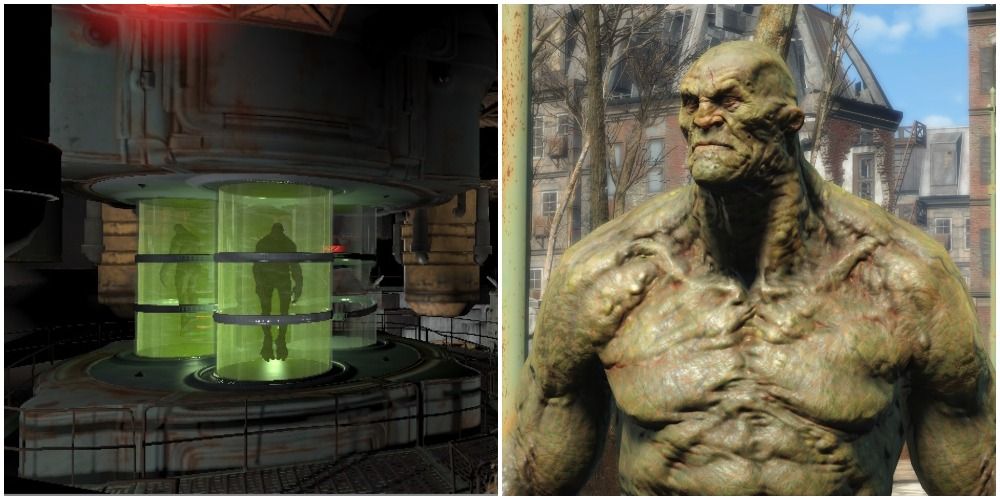Much of Fallout's many creatures roaming the wastes have not occurred naturally. From fire ants, to super mutants and intelligent Deathclaws, there is a single artificial virus to thank for many of the creatures in the wasteland: The Forced Evolutionary Virus, or FEV for short. Different organizations have used and adapted it for different agendas both before and after the Great War.
The FEV typically was used by antagonists in the Fallout universe, often in an attempt to make super-races or weaponized creatures. The strains are varied, are related to a diverse amount of projects, and have a major history both within and outside the timeline of the games. The lore put into this fictional virus is massive.
FEV's Pre-War History
Before the Great War, there was a plague in the United States, simply called the "New Plague." China also was making biochemical weapons in the Sino-American War between them and the United States. The Forced Evolution Virus originated from the research to both find a cure for the plague, as well as a way to defend against China's biological weapons. The goal was to make a biological defense against any infections and the project was dubbed the "Pan-Immunity Virion Project."
A particular batch that resulted from the research project, batch 10-011, was renamed the Forced Evolutionary Virus, and had a different structure from all other batches that the U.S. Army found promising. Single-celled organizations were experimented on with the batch in the year 2075, and the results were an immunity to radiation and infection. Plants were experimented on but had no results. Flatworms were the next experiment and showed an increase in size as well as contagion resistance.
The flatworms even got a new DNA structure, which showed the beginnings of the FEV being able to be passed on to the next generation. Mice were the next creatures to be successfully infected with FEV. They showed the same size and immunity increase. What was new, though, is they also displayed an increase in intelligence. Rabbits came next in the FEV experiments, and they showed more aggression, especially the males.
Fast-forward to 2076, and 53 raccoons got infected with the newest strain of FEV. Their size, dexterity, and intelligence increased, and they actually managed to escape their confinement. All were found and eliminated except two pairs, which were never found. Shortly after, human test subject experiments began. This was dubbed the Super Mutant Program, and was quite unethical, as the experiment poisoned the water supply of a town called Huntersville to test long-term low-level exposure to FEV. In the same year, dogs got tested as well, with increased aggression but no increase in intelligence. Chimpanzees were next, and some died of seizures caused by the virus.
After all these experiments, the FEV reached a point of a perfect success rate in lab experiments, doubling test subjects' intellect and increasing their size by 60 percent. It was believed to be the beginning of creating super soldiers for the Sino-American War. Vault-Tec began their own research efforts into the virus in some of their vault labs. Labs in Appalachia experimented with a variety of strains, though some of their experiments ended up escaping into the wild. The experiments, despite the escapes, did find a way to produce super-soldiers. However, the soldiers involved with the experiments rebelled against the science staff and executed them all before the Great War.
Creatures And Projects Made From The FEV
The many creatures touched by the FEV were both accidental and purposeful. The albino male rats of Fallout and Fallout 2 are products of escaped lab rats from the West Tek Research Facility. Of course, all super mutants are products of the FEV, though different factions of them come from different strains, which can make them vary in terms of size and intelligence.
With the FEV, the Enclave managed to create intelligent Deathclaws (though they were later all terminated). In the Capital Wasteland, a scientist used the FEV to make giant fire ants that could breathe fire. In Nuka-World's Safari Adventure, the Gatorclaws are made from the hybridization of alligator and Jackson chameleon DNA along with a strain of FEV.
Various organizations have used the FEV virus for experiments and their own agendas. In Fallout 3, the Enclave created a modified version of the virus that could eradicate super mutants and ghouls (though it also kills humans with any kind of mutation). The Commonwealth's Institute also did FEV research, kidnapping wasteland citizens, trying different strains of them, and then either killing them or releasing them back into the outside world. The Master, an FEV mutant and the main antagonist of Fallout, had the goal of making super mutants to reform humanity and be the new dominant race.
Fallout 76 is available now on PC, PS4, PS5, Xbox One, and Xbox Series X/S.


.jpg)
